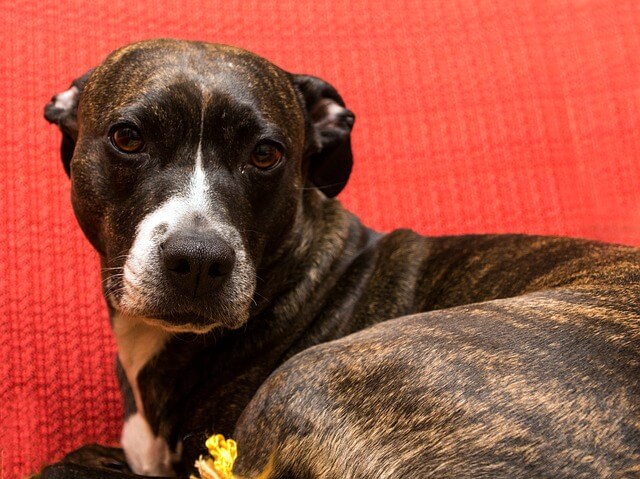My practice cares for a large number of pit bull and pit bull type dogs. They are stoic and kind. They do seem to be predisposed to certain issues everyone should be aware of. Certain diseases seem to crop up more often in certain types of dogs. These are known as breed associated disorders. Each type of dog has its own list, but many of the issues are shared by multiple breeds. Very few of these types of issues are exclusive to a single breed.

Three particular groups of issues come to my mind when I think of Pit Bulls and their health.
1. Skin Disease
Pit Bulls and crosses seem to be at an increased risk for Demodecosis. Demodecosis is a medical term for mange caused by the overgrowth of the Demodex spp. mite. These pesky little bugs can be found in very low numbers on the skin of normal dogs, but when they overpopulate and create hair loss and redness, they become a problem. It is thought to be an immune dysfunction of certain dogs that allows the mites to survive and reproduce unchecked, so affected dogs should be spayed or neutered to prevent passing on this tendency. Your veterinarian can help make this diagnosis and recommend a treatment plan based on you and your dog’s individual needs.
Atopic Dermatitis is an allergy to something that is inhaled, like pollen, mold or dust. In my practice, we see an increased number of Pit Bulls suffering from this issue. It affects many dogs, even mixed breeds and is one of the most common skin diseases in a veterinary practice. Certainly every dog lover should be aware. It is characterized by itching, paw licking, chewing biting and scratching. Atopic dogs will often have hair loss and an odor to their skin also. Atopy is not curable, but the symptoms can be managed with your vet’s help.

2. Orthopedic issues
Orthopedic issues include trouble with bones and joints. Hip Dysplasia and Osteoarthritis are common problems in Pit Bulls and crosses. The hip joint is a ball and socket joint and hip dysplasia causes malformation of the components leading to hip instability. There can be abnormalities in the either the ball or the socket (or both) and the chronic laxity causes abnormal wear and leads to osteoarthritis. There is a strong genetic correlation for hip dysplasia in certain breeds. The signs in affected dogs managed, but most cases require lifelong management. You need your vet’s help to find out if these issues are a problem for your dog. Osteoarthritis can (and does) occur independent of hip dysplasia and is common in older dogs, including Pit Bulls. Don’t assume that your dog is just getting older, there are things we can do.
3. Anxiety Disorders
It is believed that certain dogs (and certain people, too) have brain chemistry more prone to anxiety disorders. Pit Bulls seem to have this type of genetic predisposition. In fact, fear does seem to localize to specific genes in animals.1 It is interesting, however, that environmental factors play a role in the development of separation anxiety for all breeds. Lack of socialization for puppies and lack of exercise both played a role as risk factors for separation anxiety.
What Can You Do?
Make a note of any itching or missing hair and seek help sooner rather than later. Always observe your dog in motion and when he is rising from lying down and note any slowness or reluctance to move to mention to your vet. If you have a puppy that is trying to learn about being a dog and being a companion, make sure that you are complete in his or her exposure to things. Basic obedience training helps in more ways than one. It gives you a partnership with your dog where you know that you can provide some guidance for his behavior and it also develops his confidence because he learns that there is always something he can do that will please you and gives you an opportunity to bond.
Pit bulls are cherished for many traits. These issues are “pit falls”, but if you think that your dog could be affected by any of these issues, remember that your vet can help.
Do you love Pit Bulls? Me too! Find me on Facebook to learn more about them and other animals by clicking here.
- Geneticmapping of canine fear and aggression. BMC Genomics. 2016 Aug 8;17:572. doi: 10.1186/s12864-016-2936-3.Zapata I, Serpell JA, Alvarez CE.
